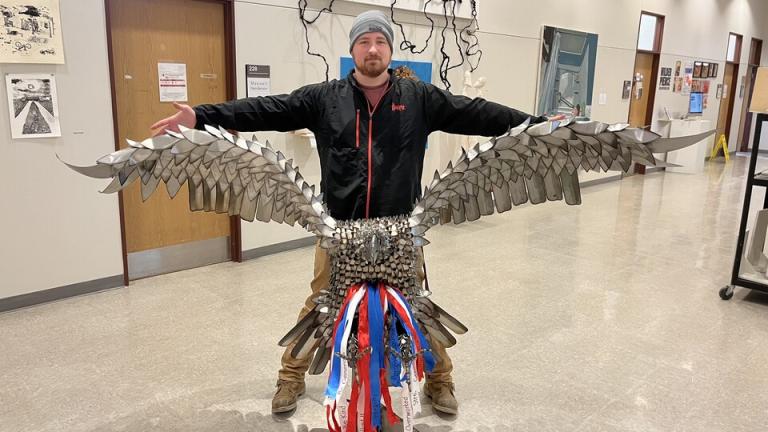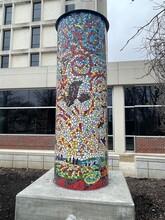
Art program helps veteran discover his passion after military service
calendar icon28 Apr 2023 user iconBy Ariana Joy Cobler, Military and Veteran Success Center

Lincoln, Neb.--The definitive “clink” of ceramics fills a Richards Hall art studio as a group of students carefully sort handfuls of mosaic tiles, focused on keeping them from falling and shattering on the floor.
Among the throng is Luke Keilig, a 25-year-old U.S. Army veteran and junior art major. A native of Ravenna, Nebraska, Keilig is working on a community mosaic with support from the Undergraduate Creative Activities and Research Experiences program. The stipend-based UCARE program offers students an opportunity to engage in world-class professional development under faculty mentors on a research or creative project.
With the guidance of Eddie Dominguez, professor of art, Keilig and the other students have developed a set of mosaic designs over the course of the spring semester. The multicolored displays are on course to be completed by the end of this April, leaving time to create a second set this summer. The first set is to be displayed in front of the Bryan Medical Center West Campus where two, nine-foot-tall pillars stand. One has geometric patterns with colors and shapes; the second is a sky with eagles, swans and flowers cascading into a lower landscape. A third, which will be installed as weather permits, will be a cluster of clouds with words submitted by hospital staff. Together, the mosaic encrusted columns will commemorate the communities’ experiences during the COVID-19 pandemic.
“I thought it would be a nice extension to work with a group of people outside of the department in a different environment with a whole similar cause,” Dominguez said. “And I think he’s gained a lot from it.”
Keilig’s artistic journey did not start with pen to paper or brush to canvas. It’s rooted in Poland, where, in 2017, Keilig’s shoulders were seriously injured while the former U.S. Army Tank Crewman was switching trackpads. The injury forced Keilig’s medical discharge and ended his military service.
“Just talking with my grandpa and uncles that had served and listening to their stories and experiences made me feel like it was something that I wanted to do and led me to going into the military, and also gave me a little more time to figure out what I wanted to do,” Keilig said.
Keilig’s post-military transition to civilian life was not as smooth as he had hoped. He stayed with his parents for a few months before enrolling at the University of Nebraska–Lincoln in 2020, but was unsure of himself and his life’s direction.
“I actually went into mechanical engineering for my first year at UNL, and it was definitely very stressful and just getting back into the groove of school after four years of service,” Keilig said. “You go from more of a structured system where you have your group of people, like a family you served with, to a whole new environment.”
Keilig soon made a rediscovery and a new career path. He reconnected with art classes — a high school passion before joining the Army. With the help of Dominguez and support from the UCARE program, Keilig redirected and became an art major.
“I was always kind of unsure,” Keilig said. “I knew I wanted to do something creative. I was always into art, or like architecture or engineering, something that’s more hands on.”
Although the change from mechanical engineering to art was difficult, he had taken art in high school, and always enjoyed creating. Even while in the military, Keilig drew tattoos for others and himself. He wanted to make the switch because it was something that he genuinely enjoyed and he hopes to one day teach.
“I have my options open to being an art teacher,” he said. “I’m getting my minor in coaching, which will be the equivalent to a coaching endorsement. So, if I want to be an art teacher, I plan on getting my alternative teaching certificate after I graduate.”
After joining the UCARE program, Keilig’s involvement deepened. He learned from peers and professors beyond the classroom and made connections outside of academic life with other talented individuals with similar passions. Mentors such as Dominguez get to interact with students to strengthen their skills over time.
“I wanted to develop his talent because I recognized that (Keilig) was very skillful,” Dominguez said. “He’s smart, he’s quiet, but he did everything with the fullest attention.”
Dominguez encouraged Keilig to be creative and explore his own ideas, which is how he began displaying his past experiences through art. The experimentation with unconventional materials like towels, sponges, flowers and netting exposed various textures revealing characteristics that Keilig associated with his military background.
“I guess the one thing that led from doing the public art piece was my flag of flowers, because that one was my own project along with a metal Eagle,” Keilig said.
Keilig’s personal projects highlighted many of his life experiences in the military. While experimenting, he had discovered that firing towels dipped in liquid clay created an illusion like a flag. He wanted to go one step further and test the technique on a few flowers that had been sitting nearby. This creative curiosity led to the creation of an American flag consisting of 392 ceramic flowers.
“I could remember I had over 200 hours in that project,” he said. “It was weeks, just making the flowers and then waiting for them to dry. And then firing them all, which took about a day.
“I’d probably make maybe around 50 at a time, then once done firing, I glazed each one and then had to re-fire. Then I ended up getting a turf to lay on the ground so it could resemble the grass. I placed all the flowers on top of the turf to create the flag.”
Following the creation of the flower flag memorial, Keilig sought out other ways to tell his story and became fascinated with sculpture. The eagle he fabricated is eight-feet wide and entirely metal — a piece he named “Self Sacrifice.” It features ribbons bursting out in red, white and blue. Each color showcases wars, internal difficulty and casualties.
The work has become a creative outlet, allowing Keilig to intertwine his personal accounts from military service with civilian life — work that has helped him cope with personal change. The practice of undergoing art projects to benefit those with emotional distress has been helping veterans reconvene after military service.
Dominguez reaffirmed that art therapy allows people to express their own emotions creatively. This not only gives the artist a sense of control and grounding but also viewers to have a glimpse of what may be hard for an individual to put into words.
“I do believe that creativity is a tool towards healing. Writing, dancing, singing, frying, I don’t care what it is, cooking, gardening. It can be a multitude of creative activities that I personally would always umbrella under art,” Dominguez said.
Keilig has utilized art to convey meaning in his civilian lifestyle while paying homage to his unforgettable memories that the military gave to him. Creating sculptures that resonate within the community maintains his beliefs that the path he has paved will continue to be the right one.
“I do keep in contact with a few of my military buddies, some of them got out some of them are still in but I definitely relied on them,” Keilig said.